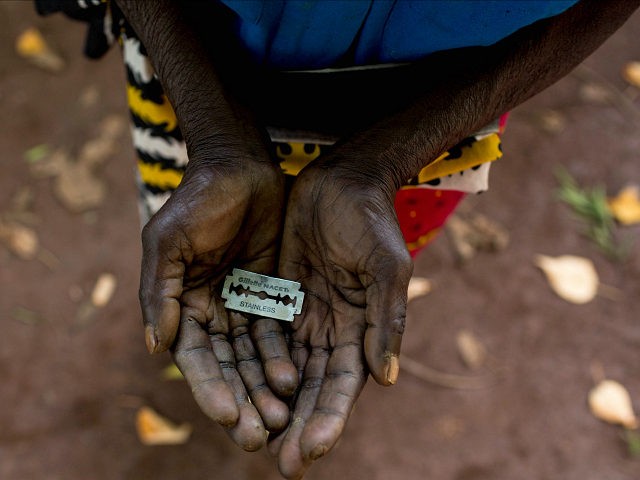Human rights groups are condemning The Economist for publishing a column promoting “the least nasty version” of female genital mutilation (FGM). Experts believe that even a “symbolic nick” can be as physically and psychologically damaging as any surgical procedure involving the removal of female genitalia for religious reasons.
In a column titled “An Agonizing Choice,” the magazine argues that it may be more advantageous to promote female genital mutilation conducted by medical professionals that cover less of a girl’s genital area rather than calling for the eradication of all mutilation procedures. “Instead of trying to stamp FGM out entirely, governments should ban the worst forms, permit those that cause no long-lasting harm and try to persuade parents to choose the least nasty version, or none at all,” the column argues. “However distasteful, it is better to have a symbolic nick from a trained health worker than to be butchered in a back room by a village elder.”
Bizarrely, the column goes on to note that the campaign to eradicate the practice entirely has been significantly successful. While an estimated 400,000 women are known to undergo some form of FGM annually, those numbers have dropped in areas where advocacy groups have opposed the practice. “Between 1985 and 2015 the countries where FGM is most common saw the share of girls cut fall from 51% to 37%,” The Economist notes.
The article also notes that attempts to promote an allegedly “milder” form of the practice have failed: “Various Western doctors have advocated offering minor forms of genital cutting to sub-Saharan immigrants, in the hope of sparing their daughters from a trip home for infibulation. Each time the outrage — from the UN, activists and many other medics — has forced them to retract.”
“Might ‘harm reduction’ lend spurious legitimacy to all types of FGM? Yes, but it has worked in other fields,” the column argues anyway.
Female genital mutilation is the practice of cutting off any or all of a girl’s outer genitalia, with the goal of preventing the girl from ever experiencing sexual pleasure as a woman. Without the ability to enjoy sex, proponents argue, the girls will grow up to be loyal and faithful wives. The practice is widespread in many Muslim societies, although it is not mandated by any religious texts. Throughout Africa and the Middle East, FGM is often conducted clandestinely by traditional herbalists in private homes, leading to infections and errors in the mutilation process.
The NGO 28 Too Many published a report this year arguing that even FGM procedures conducted by doctors in certified hospitals scar women for life and that the push by some to encourage allegedly more humane forms of the practice has legitimized it and made the work of human rights activists more difficult.
“One of the challenges of the current worldwide campaign against FGM is the trend of medicalisation; that is, attempting to minimise health risks associated with the FGM procedure by having it performed by healthcare providers,” the report notes:
[A]lthough medicalisation can contribute to the reduction of immediate risks such as infection and pain, it fails to eliminate long-term gynaecological and obstetric complications, as well as life-long emotional, psychological and sexual problems…
While the medicalisation of FGM can contribute to the reduction of acute risks such as pain or the spread of infections, it fails to eliminate long-term gynaecological and obstetric problems. What is more, medicalising FGM does not result in a diminished risk of longterm emotional, psychological and sexual problems triggered by the traumatic experience.
“As a result of [medicalization] campaigns, diverse communities around the world now believe that performing medicalised FGM is an appropriate and sufficient response to the health risks associated with the practice,” the report concludes.
Among those communities are nations like Egypt, Eritrea, Somalia, and Sudan, where the range of women whose genitalia are permanently harmed is between 80 to 90 percent, according to the report. Nor is FGM limited by geography. According to recent studies, the number of cases of FGM has risen exponentially in the West, particularly in the United States. The number of girls found to have suffered through FGM is “threefold higher than the last time we did a similar estimate in the ’90s and, in fact, fourfold higher in girls under the age of 18,” Dr. Thomas Clark, a medical epidemiologist for the U.S. Centers for Disease Control, said earlier this year.
More than 500,000 women and girls in America are at risk of being forced to undergo FGM, the CDC concluded.
Activists working to eradicate the practice have issued impassioned responses to The Economist. “Working on taboo and neglected issues like ending FGM is hard enough without well-respected publications like the Economist creating policy on the hoof and taking a line that puts our discussions back by decades,” Julia Lalla-Maharajh, the CEO of the anti-FGM charity Orchid Project, told The Guardian. The organization has called the column “grossly irresponsible.” To illustrate the danger, The Guardian notes that it has information indicating that a sect of Shia Muslims in India who practice FGM have praised the column for “writing something in our favor.”

COMMENTS
Please let us know if you're having issues with commenting.